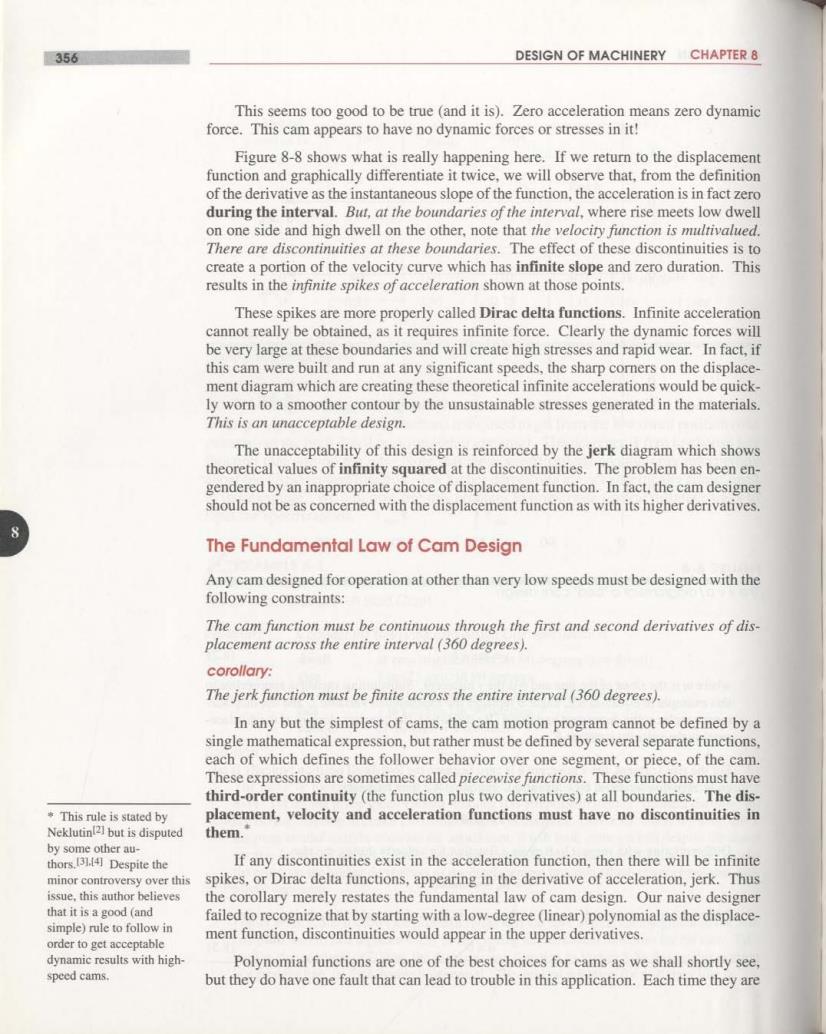正在加载图片...

356 DESIGN OF MACHINERY CHAPTER 8 This seems too good to be true (and it is).Zero acceleration means zero dynamic force.This cam appears to have no dynamic forces or stresses in it! Figure 8-8 shows what is really happening here.If we return to the displacement function and graphically differentiate it twice,we will observe that,from the definition of the derivative as the instantaneous slope of the function,the acceleration is in fact zero during the interval.But,at the boundaries of the interval,where rise meets low dwell on one side and high dwell on the other,note that the velociry function is multivalued. There are discontinuities at these boundaries.The effect of these discontinuities is to create a portion of the velocity curve which has infinite slope and zero duration.This results in the infinite spikes of acceleration shown at those points. These spikes are more properly called Dirac delta functions.Infinite acceleration cannot really be obtained,as it requires infinite force.Clearly the dynamic forces will be very large at these boundaries and will create high stresses and rapid wear.In fact,if this cam were built and run at any significant speeds,the sharp corners on the displace- ment diagram which are creating these theoretical infinite accelerations would be quick- ly worn to a smoother contour by the unsustainable stresses generated in the materials. This is an unacceptable design. The unacceptability of this design is reinforced by the jerk diagram which shows theoretical values of infinity squared at the discontinuities.The problem has been en- gendered by an inappropriate choice of displacement function.In fact,the cam designer should not be as concerned with the displacement function as with its higher derivatives. 8 The Fundamental Law of Cam Design Any cam designed for operation at other than very low speeds must be designed with the following constraints: The cam function must be continuous through the first and second derivatives of dis- placement across the entire interval (360 degrees). corollary: The jerk function must be finite across the entire interval(360 degrees). In any but the simplest of cams.the cam motion program cannot be defined by a single mathematical expression,but rather must be defined by several separate functions. each of which defines the follower behavior over one segment,or piece,of the cam. These expressions are sometimes called piecewise functions.These functions must have third-order continuity (the function plus two derivatives)at all boundaries.The dis- ◆This rule is stated by placement,velocity and acceleration functions must have no discontinuities in Neklutinl21 but is disputed them." by some other au- thors.3114 Despite the If any discontinuities exist in the acceleration function,then there will be infinite minor controversy over this spikes,or Dirac delta functions,appearing in the derivative of acceleration,jerk.Thus issue,this author believes the corollary merely restates the fundamental law of cam design.Our naive designer that it is a good (and failed to recognize that by starting with a low-degree (linear)polynomial as the displace- simple)rule to follow in ment function,discontinuities would appear in the upper derivatives. order to get acceptable dynamic results with high- Polynomial functions are one of the best choices for cams as we shall shortly see, speed cams. but they do have one fault that can lead to trouble in this application.Each time they are